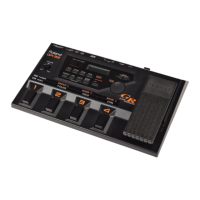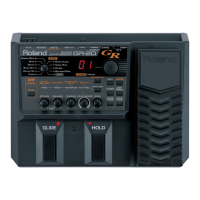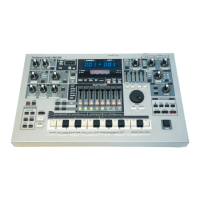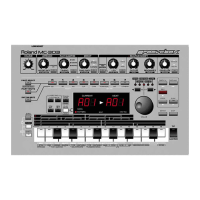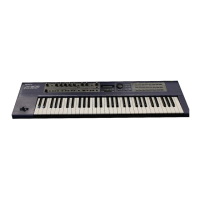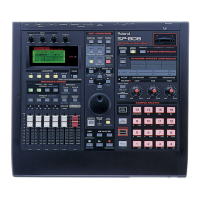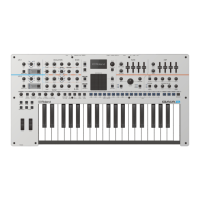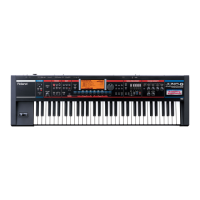Practical Use of MIDI Channels
<<fig. 10-5>>
A single MIDI system has 16 channels, and ordinarily
16 instrument parts can exist.With a guitar synthesiz-
er, however, each of the six strings takes up one chan-
nel.
This means that, for instance, two-part input with the
guitar synth to an ensemble from a 16-part external
multitimbral sound generator would use up 12 chan-
nels.
In cases like this, set the MIDI channel (p. 71) to a
value from “1.P” to “16.P” and send input to the
sequencer with Poly mode sending. This lets you
proceed with recording while using up only one
channel per part, as with a keyboard instrument.
One drawback of transmitting in Poly mode is that it
is not possible to send Pitch Bend messages for bend-
ing, sliding, vibratos, and the like when playing
chords, but this mode can help in economical use of
channels and parts when used judiciously separately
from Mono mode input while giving consideration to
the tones to be used and to single-note playing.
Also, when also adding the GR-30’s sound generator
to the ensemble, the use of Poly mode for receiving as
well as sending lets the GR-30’s parts use just one
channel, leaving the remaining 15 channels for use by
the multitimbral sound generator.
To enable receiving in Poly mode, switch on the
power while holding down the [+] button. (At this
time, the GR-30 starts up unconditionally with local
control off.) For a detailed explanation of behavior
when receiving in Poly mode, take a look at “Using
the GR-30 As an Expansion Sound Device for
Keyboards and Like Devices (Poly Mode)” on p. 82.
Mono Mode ch1 Mono Mode ch7
Only 4 channels
remaining available for use
14 channels remaining available for use
Transmitting in Mono Mode
Transmitting in Poly Mode
Guitar 1
Guitar 2
1
MIDIch
2345678910111213141516
In use
Poly Mode ch1
Poly Mode ch2
Guitar 1
Guitar 2
1
MIDIch
2345678910111213141516
In use
80
What to do When You Have Difficulty Sequencing
❍ Double-check the MIDI cable connections (OUT ->
IN, p. 77) and the setting for local control (on or off
— p. 78).
❍ When performing playback, be sure to check the
MIDI channel and Bend Range settings (p. 71).
❍ Be sure that the transmitting and receiving modes
(Mono or Poly) match up. If only the sound for
one string is heard during playback, you may be
sending performance data to created with trans-
mission in Mono mode a non-multitimbral sound
generator (including the GR-30, if set for receiving
in Poly mode).
❍ If MIDI cannot be sent and recording is impossible
for only a particular string, adjust the STRING
SELECT knob to the string’s number and make
sure that the MIDI “PG CHNG#” setting is not
“oFF” (p. 72).
❍ During transmission in Poly mode, pitch changes
for chord play are in semitone steps. If continuous
change in pitch is needed, use single-note playing
or transmission in MIDI Mono mode.
❍ If MIDI Bend Range is set to “1” or “2,” unpleasant
retriggering of sounds may occur frequently dur-
ing a performance with continuous changes in
pitch through bending or the like. When using the
same Bend Range setting for both sending and
receiving, make the value as large as possible (p.
71).
❍ To achieve faster sound generation and smooth
pitch changes, the GR-30 transmits pitch as a combi-
nation of Note messages and Pitch bend messages.
This means that if the sequencer’s microscope
(event list) screen shows only Note messages, what
appears on-screen may differ from what is actually
performed. If continuous pitch change is not
required, you can create data that is displayed more
faithfully by setting the sending Bend Range to “0.”

